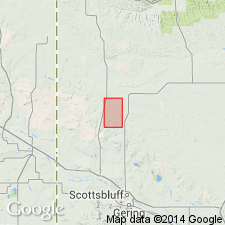
- Usage in publication:
-
- Hemingford group
- Modifications:
-
- Original reference
- AAPG geologic province:
-
- Chadron arch
Summary:
Pg. 226, 227; GSA Bull., v. 50, no. 8, p. 1253-1254, 1939. Hemingford group. Includes Marsland below and Sheep Creek formations. Thickness 250 to 350 feet. Unconformable above Arikaree group (redefined) and below Ogallala group (redefined). [Recognized in Nebraska and Wyoming. Age is Miocene.] Name suggested by C.B. Schultz.
[Named from town of Hemingford, Hemingford 7.5-min quadrangle, Box Butte Co., northwestern NE.]
Source: US geologic names lexicon (USGS Bull. 1200, p. 1729).
- Usage in publication:
-
- Hemingford Group
- Modifications:
-
- Revised
- AAPG geologic province:
-
- Chadron arch
Galusha, T., 1975, Stratigraphy of the Box Butte Formation, Nebraska: American Museum of Natural History Bulletin, v. 156, art. 1, p. 1-68.
Summary:
Hemingford Group. Revised to include (descending) "Lower Snake Creek" beds, Sheep Creek Formation (revised), Box Butte Formation (revised), Runningwater Formation, and Marsland Formation ("Upper Harrison"). Underlies Ogallala Group and overlies Arikaree Group. Age is Miocene (Hemingfordian to Barstovian NALMA).
Source: Publication.

- Usage in publication:
-
- Hemingford Group
- Modifications:
-
- Revised
- Age modified
- Biostratigraphic dating
- AAPG geologic province:
-
- Denver basin
Summary:
Pg. 292-306. Hemingford Group. Revised to include Olcott Formation (new) at top; sediments previously included in Snake Creek Formation (restricted) of Ogallala Group. In this region, the Hemingford includes (in descending order) Olcott Formation (new), Sheep Creek Formation (restricted), and Marsland Formation (="Upper Harrison" of Peterson, 1906). Underlies Ogallala Group; overlies Arikaree Group. Fossils (vertebrates). Age is early to early middle Miocene (Hemingfordian to early Barstovian NALMA).
Source: Publication.
- Usage in publication:
-
- Hemingford Group[†]
- Modifications:
-
- [Abandoned]
- AAPG geologic province:
-
- Chadron arch
- Denver basin
Swinehart, J.B., Souders, V.L., DeGraw, H.M., and Diffendal, R.F., Jr., 1985, Cenozoic paleogeography of western Nebraska: Society of Economic Paleontologists and Mineralogists, Rocky Mountain Section, Rocky Mountain Paleogeography Symposium, v. 3, p. 209-229., Reprinted as University of Nebraska-Lincoln, Conservation and Survey Division, Reprint Series, no. 52
Summary:
Pg. 211, 212 (fig. 4), 213 (table 1). [†Hemingford Group abandoned.] Ogallala Group expanded to include (descending) the Olcott, Sheep Creek, Box Butte, and Runningwater Formations. "Upper Harrison" beds [Marsland Formation] reallocated to underlying Arikaree Group. [As revised, maximum thickness of the Ogallala is 1,560 feet, Arikaree is 1,070 feet thick.]
Source: Publication.
For more information, please contact Nancy Stamm, Geologic Names Committee Secretary.
Asterisk (*) indicates published by U.S. Geological Survey authors.
"No current usage" (†) implies that a name has been abandoned or has fallen into disuse. Former usage and, if known, replacement name given in parentheses ( ).
Slash (/) indicates name conflicts with nomenclatural guidelines (CSN, 1933; ACSN, 1961, 1970; NACSN, 1983, 2005, 2021). May be explained within brackets ([ ]).

